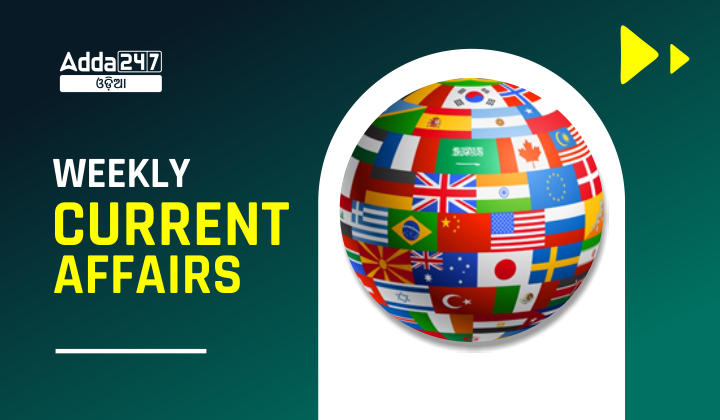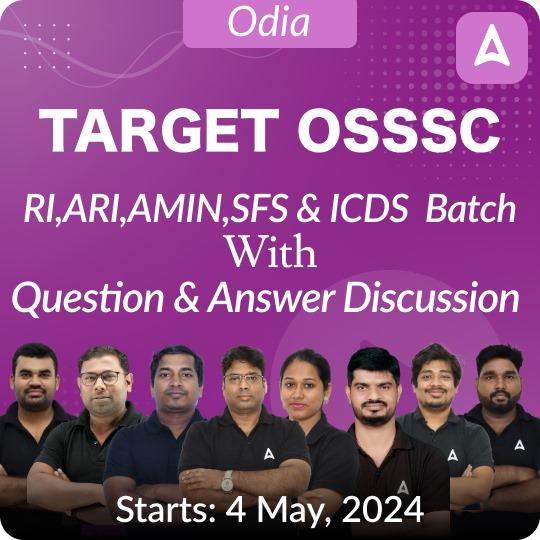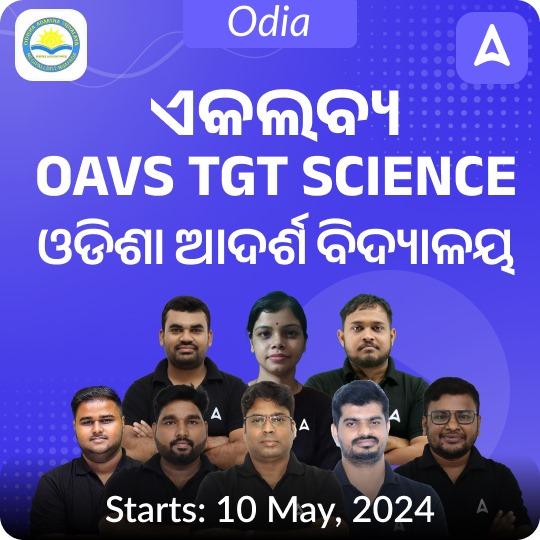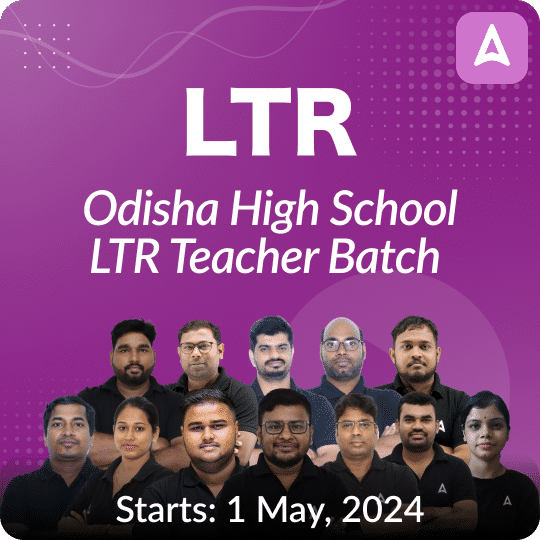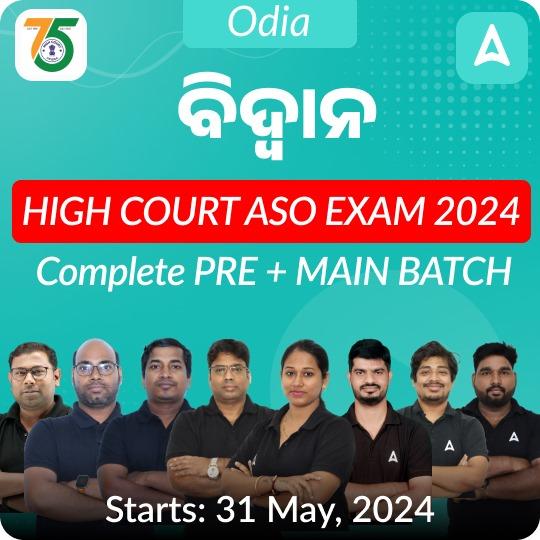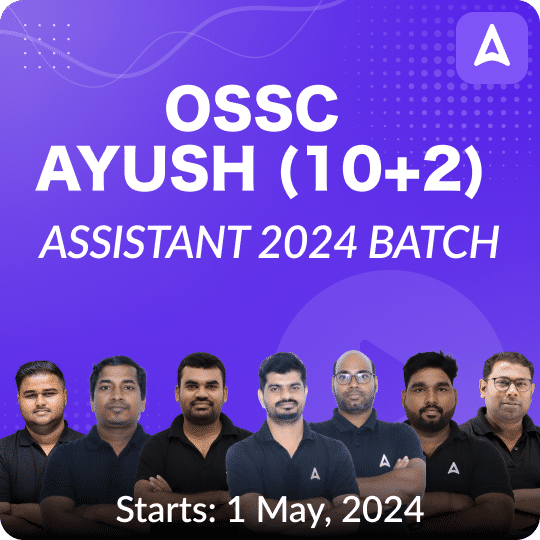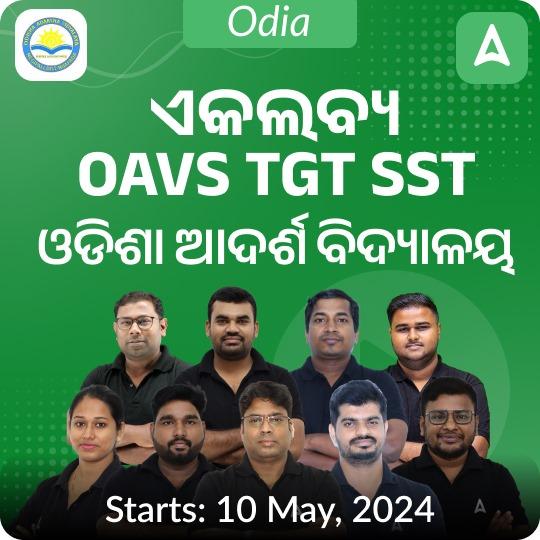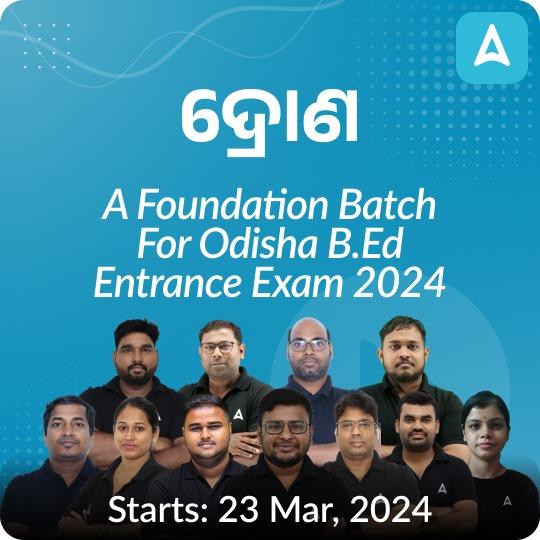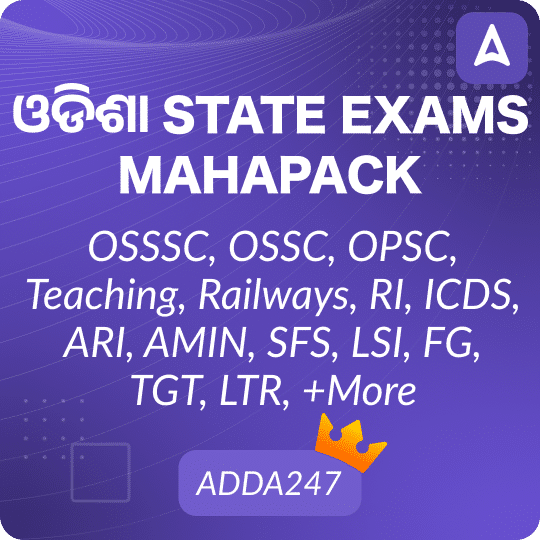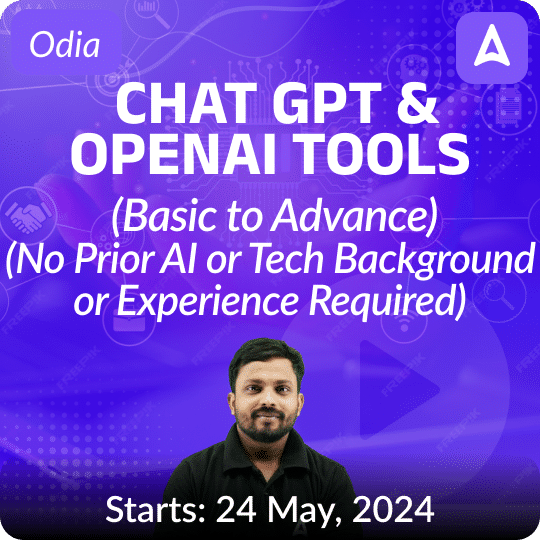Weekly Current affairs play a very important role in the competitive examinations and hence, aspirants have to give undivided attention to it while doing preparation for the government examinations. The CGLRE, OCS examinations comprise a section of “Current Affairs” to evaluate how much the aspirant is aware of the daily happenings taking place around the world. To complement your preparation, we are providing you with a compilation of Weekly Current affairs.
- What weight category does the term “megafauna” refer to?
(a) Animals weighing more than 10 kg
(b) Animals weighing more than 20 kg
(c) Animals weighing more than 50 kg
(d) Animals weighing more than 100 kg
Ans: (c) Animals weighing more than 50 kg - Who first used the term “megafauna”?
(a) Charles Darwin
(b) Alfred Russel Wallace
(c) Alexander von Humboldt
(d) Carl Linnaeus
Ans: (b) Alfred Russel Wallace - What diet category do ostriches fall under?
(a) Megaherbivores
(b) Megacarnivores
(c) Megaomnivores
(d) Megainsectivores
Ans: (c) Megaomnivores - What is the typical weight range of an ostrich?
(a) 50-90 kg
(b) 90-140 kg
(c) 140-200 kg
(d) 200-250 kg
Ans: (b) 90-140 kg - What is the height range of an ostrich?
(a) 3-5 feet
(b) 5-7 feet
(c) 7-9 feet
(d) 9-11 feet
Ans: (c) 7-9 feet - What is the primary aim of the India-Mongolia Joint Military Exercise NOMADIC ELEPHANT?
(a) Enhance naval capabilities
(b) Enhance air combat skills
(c) Enhance joint military capability for counter-insurgency operations
(d) Enhance diplomatic relations
Ans: (c) Enhance joint military capability for counter-insurgency operations - Which Indian battalion represents the Indian contingent in the NOMADIC ELEPHANT exercise?
(a) GARHWAL RIFLES
(b) SIKKIM SCOUTS
(c) BIHAR REGIMENT
(d) MARATHA LIGHT INFANTRY
Ans: (b) SIKKIM SCOUTS - Where is the 2024 edition of the NOMADIC ELEPHANT exercise taking place?
(a) Mongolia
(b) Sikkim
(c) Meghalaya
(d) Rajasthan
Ans: (c) Meghalaya - What is the duration of the ‘Sampoornata Abhiyan’ launched by NITI Aayog?
(a) 1st June to 31st August 2024
(b) 4th July to 30th September 2024
(c) 1st August to 31st October 2024
(d) 4th July to 31st December 2024
Ans: (b) 4th July to 30th September 2024 - Which of the following is NOT a focus area of ‘Sampoornata Abhiyan’ in Aspirational Districts?
(a) Percentage of pregnant women registered for ANC within the first trimester
(b) Percentage of children fully immunized
(c) Percentage of rural electrification completed
(d) Percentage of schools providing textbooks within 1 month of the start of the academic session
Ans: (c) Percentage of rural electrification completed - What is the primary objective of the Saubhagya scheme?
(a) Electrification of commercial buildings
(b) Universal household electrification
(c) Providing solar panels to urban households
(d) Reducing electricity tariffs
Ans: (b) Universal household electrification - When was the Saubhagya scheme launched?
(a) January 2016
(b) October 2017
(c) April 2018
(d) March 2019
Ans: (b) October 2017 - Which agency is designated as the nodal agency for the Saubhagya scheme?
(a) NTPC
(b) Power Grid Corporation
(c) Rural Electrification Corporation (REC)
(d) NITI Aayog
Ans: (c) Rural Electrification Corporation (REC) - What type of households are eligible for free electricity connections under the Saubhagya scheme?
(a) BPL families in rural areas
(b) All urban households
(c) All rural households
(d) Industrial units
Ans: (a) BPL families in rural areas - How much does a non-BPL family in rural areas have to pay for an electricity connection under the Saubhagya scheme?
(a) Rs. 1000 in 10 installments of Rs. 100
(b) Rs. 500 in 10 installments of Rs. 50
(c) Rs. 1000 upfront
(d) Rs. 500 upfront
Ans: (b) Rs. 500 in 10 installments of Rs. 50 - Which data is used to identify beneficiaries for free electricity connections under the Saubhagya scheme?
(a) Census 2001 data
(b) Census 2011 data
(c) SECC 2011 data
(d) SECC 2021 data
Ans: (c) SECC 2011 data - What type of system is provided for households in remote and inaccessible villages under the Saubhagya scheme?
(a) Wind energy systems
(b) Diesel generators
(c) Solar Photo Voltaic (SPV)-based standalone systems
(d) Biomass energy systems
Ans: (c) Solar Photo Voltaic (SPV)-based standalone systems - Who issued notifications to the former chief secretary and other former officials of the Meghalaya Energy Corporation Limited (MeECL) regarding irregularities in the Saubhagya scheme?
(a) Meghalaya High Court
(b) Meghalaya Lokayukta
(c) Central Vigilance Commission
(d) Comptroller and Auditor General of India
Ans: (b) Meghalaya Lokayukta - What items are included in the free connections for BPL families in rural areas?
(a) LED bulbs, wire, holders, switches, etc.
(b) Only meters
(c) Only wiring
(d) Only LED bulbs
Ans: (a) LED bulbs, wire, holders, switches, etc. - Which areas are excluded from receiving free power connections in urban areas under the Saubhagya scheme?
(a) Poor households
(b) BPL families
(c) Non-poor urban households
(d) Industrial areas
Ans: (c) Non-poor urban households - What is the purpose of the Saubhagya scheme?
(a) Providing employment in rural areas
(b) Universal household electrification
(c) Development of smart cities
(d) Promotion of renewable energy
Ans: (b) Universal household electrification - Which type of households in urban areas are eligible for free power connections under the Saubhagya scheme?
(a) BPL families
(b) All urban households
(c) Non-poor households
(d) Only industrial households
Ans: (a) BPL families - What was the launch date of the Saubhagya scheme?
(a) January 2016
(b) October 2017
(c) April 2018
(d) March 2019
Ans: (b) October 2017 - The beneficiaries for free electricity connections under the Saubhagya scheme are identified using which data?
(a) Census 2011 data
(b) Census 2001 data
(c) SECC 2021 data
(d) SECC 2011 data
Ans: (d) SECC 2011 data - Which organization is responsible for implementing the Saubhagya scheme?
(a) NTPC
(b) Power Grid Corporation
(c) Rural Electrification Corporation (REC)
(d) NITI Aayog
Ans: (c) Rural Electrification Corporation (REC) - What is provided to households in remote areas where grid extension is not feasible under the Saubhagya scheme?
(a) Wind energy systems
(b) Diesel generators
(c) Solar Photo Voltaic (SPV)-based standalone systems
(d) Biomass energy systems
Ans: (c) Solar Photo Voltaic (SPV)-based standalone systems - The Meghalaya Lokayukta issued notifications regarding irregularities in the implementation of which scheme?
(a) UDAY scheme
(b) Saubhagya scheme
(c) DDUGJY scheme
(d) IPDS scheme
Ans: (b) Saubhagya scheme - What does the Saubhagya scheme aim to achieve?
(a) Employment generation
(b) Universal household electrification
(c) Development of smart cities
(d) Promotion of renewable energy
Ans: (b) Universal household electrification - Under the Saubhagya scheme, what is the cost of electricity connection for non-BPL families in rural areas?
(a) Rs. 1000 upfront
(b) Rs. 500 in 10 installments of Rs. 50
(c) Rs. 2000 upfront
(d) Free of cost
Ans: (b) Rs. 500 in 10 installments of Rs. 50 - The Rural Electrification Corporation (REC) is the nodal agency for which scheme?
(a) UDAY scheme
(b) Saubhagya scheme
(c) DDUGJY scheme
(d) IPDS scheme
Ans: (b) Saubhagya scheme - What is the main objective of the PM-Surya Ghar Muft Bijli Yojana?
(a) To provide subsidies for electric vehicles
(b) To offer free electricity up to 300 units per month
(c) To distribute LED bulbs to households
(d) To reduce the cost of electricity for industries
Ans. (b) To offer free electricity up to 300 units per month - How many households are targeted under the PM-Surya Ghar Muft Bijli Yojana?
(a) 50 lakh households
(b) 1 crore households
(c) 2 crore households
(d) 5 lakh households
Ans. (b) 1 crore households - What type of installations will be promoted under this scheme?
(a) Wind energy installations
(b) Biomass energy installations
(c) Rooftop solar installations
(d) Hydropower installations
Ans. (c) Rooftop solar installations - Who will promote rooftop solar systems in urban and rural areas?
(a) Private companies
(b) Urban local bodies and Panchayats
(c) Non-Governmental Organizations (NGOs)
(d) Educational institutions
Ans. (b) Urban local bodies and Panchayats - What is the financial benefit provided to beneficiaries under this scheme?
(a) Direct cash transfer
(b) Free electricity up to 300 units per month
(c) Tax rebate
(d) Free solar panels
Ans. (b) Free electricity up to 300 units per month - How will the financial burden on beneficiaries be managed?
(a) Through crowd-funding
(b) By offering subsidies and affordable loans
(c) By increasing taxes
(d) By reducing other welfare schemes
Ans. (b) By offering subsidies and affordable loans - How much subsidy is provided for a 1 KW solar system under the Pradhan Mantri Surya Ghar Yojana?
(a) Rs 20,000
(b) Rs 30,000
(c) Rs 50,000
(d) Rs 60,000
Ans. (b) Rs 30,000 - What is the subsidy amount for a 2 KW solar system under the scheme?
(a) Rs 20,000
(b) Rs 40,000
(c) Rs 60,000
(d) Rs 80,000
Ans. (c) Rs 60,000 - How much subsidy is provided for a 3 KW solar system or larger?
(a) Rs 50,000
(b) Rs 60,000
(c) Rs 70,000
(d) Rs 78,000
Ans. (d) Rs 78,000 - Which government is launching the PM-Surya Ghar Muft Bijli Yojana?
(a) Maharashtra Government
(b) Odisha Government
(c) Karnataka Government
(d) Gujarat Government
Ans. (b) Odisha Government - When is GST Day observed?
(a) June 1
(b) July 1
(c) August 1
(d) September 1
Ans. (b) July 1 - What significant achievement was recorded by Odisha in June 2024 concerning GST?
(a) Introduction of a new tax slab
(b) 24% growth in State GST collections
(c) Launch of a new GST portal
(d) Implementation of GST 2.0
Ans. (b) 24% growth in State GST collections - Who proposed the concept of GST in India?
(a) The Planning Commission
(b) The Kelkar Task Force
(c) NITI Aayog
(d) The Ministry of Finance
Ans. (b) The Kelkar Task Force - When was the Constitution (101st Amendment) Act enacted by the Parliament?
(a) August 2016
(b) January 2017
(c) March 2018
(d) July 2015
Ans. (a) August 2016 - What was the purpose of the GST Council?
(a) To set income tax rates
(b) To oversee the implementation of GST
(c) To regulate foreign trade
(d) To manage public sector enterprises
Ans. (b) To oversee the implementation of GST - When was GST finally implemented in India?
(a) January 1, 2016
(b) April 1, 2017
(c) July 1, 2017
(d) December 1, 2018
Ans. (c) July 1, 2017 - Who was the Chief Minister of Odisha during the launch of Subhadra Yojana?
(a) Naveen Patnaik
(b) Biju Patnaik
(c) Mohan Charan Majhi
(d) Anubhav Mohanty
Ans. (c) Mohan Charan Majhi - On what date is the Subhadra Yojana scheduled to launch?
(a) August 15
(b) October 2
(c) September 17
(d) November 14
Ans. (c) September 17 - What is the main benefit provided to women under the Subhadra Yojana?
(a) Free education
(b) Employment opportunities
(c) Cash voucher worth Rs 50,000
(d) Housing loans
Ans. (c) Cash voucher worth Rs 50,000 - During which event was the decision to implement the Subhadra Yojana approved?
(a) Second cabinet meeting
(b) Budget session
(c) First cabinet meeting of the BJP government
(d) Special assembly session
Ans. (c) First cabinet meeting of the BJP government - Why is Project Nexus in the news?
(a) Launch of a new space mission
(b) India’s inclusion in a multilateral payment initiative
(c) Introduction of a new agricultural scheme
(d) Development of a new submarine project
Ans. (b) India’s inclusion in a multilateral payment initiative - What is the primary objective of Project Nexus?
(a) To promote digital literacy
(b) To enable instant cross-border retail payments
(c) To develop new payment software
(d) To enhance cybersecurity measures
Ans. (b) To enable instant cross-border retail payments - Which countries are participants in Project Nexus alongside India?
(a) Bangladesh, Nepal, Sri Lanka
(b) Malaysia, Philippines, Singapore, Thailand
(c) China, Japan, South Korea
(d) Australia, New Zealand, Canada
Ans. (b) Malaysia, Philippines, Singapore, Thailand - Which domestic system represents India in Project Nexus?
(a) National Payments Corporation of India (NPCI)
(b) Unified Payments Interface (UPI)
(c) Reserve Bank of India (RBI)
(d) Indian Financial System Code (IFSC)
Ans. (b) Unified Payments Interface (UPI) - Why is the 16th Finance Commission in the news?
(a) Completion of its final report
(b) Commencement of its work
(c) Introduction of a new financial bill
(d) Implementation of GST
Ans. (b) Commencement of its work - What constitutional amendments emphasize local bodies’ recognition in the context of the Finance Commission?
(a) 42nd and 44th
(b) 73rd and 74th
(c) 52nd and 53rd
(d) 61st and 62nd
Ans. (b) 73rd and 74th - When is the 16th Finance Commission expected to be constituted?
(a) 2022
(b) 2023
(c) 2024
(d) 2025
Ans. (c) 2024 - Who is the chairman of the 16th Finance Commission?
(a) Dr. Manmohan Singh
(b) N.K. Singh
(c) Y.V. Reddy
(d) Shri Arvind Panagariya
Ans. (d) Shri Arvind Panagariya - Why is Project-76 in the news?
(a) Successful launch of a new satellite
(b) Design and development of an indigenous submarine
(c) Completion of a major dam project
(d) Introduction of new agricultural policies
Ans. (b) Design and development of an indigenous submarine - What type of submarines are being developed under Project-76?
(a) Nuclear-powered submarines
(b) Diesel-electric submarines with air-independent propulsion (AIP)
(c) Unmanned underwater vehicles
(d) Hybrid submarines
Ans. (b) Diesel-electric submarines with air-independent propulsion (AIP) - How many submarines does the Indian Navy plan to build under Project-76?
(a) 6
(b) 8
(c) 10
(d) 12
Ans. (d) 12 - When is the construction of the prototype submarine expected to start?
(a) 2025
(b) 2028
(c) 2030
(d) 2032
Ans. (b) 2028 - Why is the eSankhyiki Portal in the news?
(a) Launch of a new education policy
(b) Inauguration of a statistical data management portal
(c) Introduction of a digital health platform
(d) Implementation of a cybersecurity initiative
Ans. (b) Inauguration of a statistical data management portal - Which ministry launched the eSankhyiki Portal?
(a) Ministry of Finance
(b) Ministry of Home Affairs
(c) Ministry of Statistics and Programme Implementation (MoSPI)
(d) Ministry of Electronics and Information Technology
Ans. (c) Ministry of Statistics and Programme Implementation (MoSPI) - What is the theme aligned with the launch of the eSankhyiki Portal?
(a) Digital India
(b) Use of data for Decision making
(c) Statistical Innovations
(d) Data Privacy and Security
Ans. (b) Use of data for Decision making - What is the primary objective of the eSankhyiki Portal?
(a) Provide real-time inputs for planners and policymakers
(b) Facilitate online education
(c) Promote e-governance
(d) Enhance cybersecurity measures
Ans. (a) Provide real-time inputs for planners and policymakers - Why is the Agriculture Infrastructure Fund Scheme in the news?
(a) Launch of a new space mission
(b) Launch of a web portal to expedite bank settlements of interest subvention claims
(c) Introduction of new tax reforms
(d) Implementation of a national health scheme
Ans. (b) Launch of a web portal to expedite bank settlements of interest subvention claims - In which year was the Agriculture Infrastructure Fund Scheme launched?
(a) 2018
(b) 2019
(c) 2020
(d) 2021
Ans. (c) 2020 - What is the total outlay for the Agriculture Infrastructure Fund Scheme?
(a) ₹50,000 crore
(b) ₹75,000 crore
(c) ₹1 lakh crore
(d) ₹1.5 lakh crore
Ans. (c) ₹1 lakh crore - What is the primary objective of the Krishi Katha Platform?
(a) Provide digital healthcare to farmers
(b) Raise awareness about farming issues and solutions
(c) Promote foreign investments in agriculture
(d) Facilitate urban farming initiatives
Ans. (b) Raise awareness about farming issues and solutions - What is the total capacity of the HPCL wind energy project in Umerkot, Nabarangpur district?
(a) 48 MW
(b) 49.5 MW
(c) 50 MW
(d) 100 MW
Ans: (a) 48 MW - Where is the ONGC Tripura Power Company’s wind energy project located?
(a) Bhubaneswar
(b) Astaranga, Puri district
(c) Rourkela
(d) Cuttack
Ans: (b) Astaranga, Puri district - What is the total investment amount for the wind energy projects approved by the State’s Single Window Committee?
(a) ₹500 crores
(b) ₹881.28 crores
(c) ₹1000 crores
(d) ₹1500 crores
Ans: (b) ₹881.28 crores - Under which policy has Odisha approved investments totaling ₹3,723.57 crores?
(a) Odisha Green Energy Policy, 2020
(b) Odisha Renewable Energy Policy, 2022
(c) Odisha Solar Energy Policy, 2021
(d) Odisha Wind Energy Policy, 2019
Ans: (b) Odisha Renewable Energy Policy, 2022 - What is the total renewable energy capacity approved by SWC for Odisha?
(a) 300 MW
(b) 400 MW
(c) 499.48 MW
(d) 500 MW
Ans: (c) 499.48 MW - What is the primary focus of Lok Adalats as emphasized by the Orissa High Court?
(a) Acting as regular judges
(b) Imposing fines
(c) Conciliation
(d) Punishment
Ans: (c) Conciliation - What does “Lok Adalat” translate to in English?
(a) People’s Court
(b) Public Court
(c) Local Court
(d) Law Court
Ans: (a) People’s Court - Under which act are Lok Adalats established?
(a) Indian Penal Code, 1860
(b) Legal Services Authorities Act, 1987
(c) Arbitration and Conciliation Act, 1996
(d) Indian Evidence Act, 1872
Ans: (b) Legal Services Authorities Act, 1987 - Which type of Lok Adalat handles cases related to public utility services?
(a) National Lok Adalat
(b) Permanent Lok Adalat
(c) Mega Lok Adalat
(d) Mobile Lok Adalats
Ans: (b) Permanent Lok Adalat - Which type of Lok Adalat is conducted monthly across India?
(a) Permanent Lok Adalat
(b) National Lok Adalat
(c) Mega Lok Adalat
(d) Mobile Lok Adalats
Ans: (b) National Lok Adalat - Why is Odisha’s government planting palm trees?
(a) For beautification
(b) To prevent lightning-related deaths
(c) For fruit production
(d) For timber
Ans: (b) To prevent lightning-related deaths - How many palm trees does the Forest Department plan to plant in 2024-25?
(a) 10 lakh
(b) 15 lakh
(c) 19 lakh
(d) 20 lakh
Ans: (c) 19 lakh - How much is the Odisha government planning to spend on planting palm trees in 2024-25?
(a) Rs 5 crore
(b) Rs 7 crore
(c) Rs 10 crore
(d) Rs 15 crore
Ans: (b) Rs 7 crore - What permission is required for cutting down palm trees on private property in Odisha?
(a) Local municipality
(b) Forest Department
(c) Panchayat
(d) No permission required
Ans: (b) Forest Department - Why was the permission requirement to cut down palm trees initially lifted?
(a) For urban development
(b) For agriculture expansion
(c) It was not needed
(d) To boost rural palm tree populations
Ans: (b) For agriculture expansion - How much investment has been announced for Odisha’s railway projects over the next five years?
(a) ₹50,000 crore
(b) ₹1 lakh crore
(c) ₹75,000 crore
(d) ₹25,000 crore
Ans: (b) ₹1 lakh crore - What was the annual railway budget allocation for Odisha under the Modi government?
(a) ₹800 crore
(b) ₹5,000 crore
(c) ₹10,000 crore
(d) ₹15,000 crore
Ans: (c) ₹10,000 crore - How many kilometers of new railway lines were constructed in Odisha in the past decade?
(a) 1,000 km
(b) 1,500 km
(c) 1,826 km
(d) 2,000 km
Ans: (c) 1,826 km - For the Rath Yatra in Puri, how many special trains were planned from 25 districts of Odisha?
(a) 100
(b) 200
(c) 315
(d) 400
Ans: (c) 315 - What new projects are proposed for Odisha apart from railway investments?
(a) Solar power plants
(b) Electronic manufacturing cluster and semiconductor training center
(c) New airports
(d) Shipping ports
Ans: (b) Electronic manufacturing cluster and semiconductor training center - What is SEBEX 2?
(a) A non-nuclear explosive
(b) A nuclear missile
(c) An AI algorithm
(d) A spacecraft
Ans: (a) A non-nuclear explosive - SEBEX 2 is how many times more deadly than standard TNT?
(a) 0.9 times
(b) 1.01 times
(c) 1.1 times
(d) 2 times
Ans: (b) 1.01 times - Who manufactured SEBEX 2?
(a) Indian Army
(b) Economic Explosives Limited (EEL)
(c) DRDO
(d) HAL
Ans: (b) Economic Explosives Limited (EEL) - SEBEX 2 was developed under which initiative?
(a) Atmanirbhar Bharat
(b) Make in India
(c) Skill India
(d) Startup India
Ans: (b) Make in India - Which organization certified SEBEX 2?
(a) ISRO
(b) Indian Navy
(c) DRDO
(d) IAF
Ans: (b) Indian Navy - What is AI Washing?
(a) Cleaning AI servers
(b) Exaggerating the use of AI in products
(c) An AI maintenance process
(d) Removing biases from AI
Ans: (b) Exaggerating the use of AI in products - The term AI Washing is derived from which of the following?
(a) Brainwashing
(b) Greenwashing
(c) Powerwashing
(d) Machine washing
Ans: (b) Greenwashing - Which of the following is an example of AI Washing?
(a) Using AI to detect cancer
(b) Claiming a basic chatbot is powered by AI
(c) Developing autonomous vehicles
(d) Using AI for weather forecasting
Ans: (b) Claiming a basic chatbot is powered by AI - What is the main objective of AI Washing?
(a) Reduce costs
(b) Capitalize on the interest in AI
(c) Improve AI algorithms
(d) Increase data security
Ans: (b) Capitalize on the interest in AI - AI Washing can make products seem:
(a) Outdated
(b) Cutting-edge
(c) Less reliable
(d) More expensive
Ans: (b) Cutting-edge - What medical condition did Oran Knowlson have that led to the use of the Deep Brain Stimulation device?
(a) Parkinson’s disease
(b) Epileptic seizures
(c) Alzheimer’s disease
(d) Multiple sclerosis
Ans: (b) Epileptic seizures - Which of the following techniques does the Deep Brain Stimulation device use?
(a) Magnetic resonance imaging
(b) Ultrasound
(c) Electrical impulses
(d) Radiotherapy
Ans: (c) Electrical impulses - What is the primary function of the Deep Brain Stimulation device?
(a) Enhance memory
(b) Block abnormal seizure-causing signals
(c) Improve vision
(d) Increase muscle strength
Ans: (b) Block abnormal seizure-causing signals - How can the Deep Brain Stimulation device be recharged?
(a) Wired connection
(b) USB cable
(c) Solar power
(d) Wireless headphone
Ans: (d) Wireless headphone - The Deep Brain Stimulation device was initially used for which disorder?
(a) Depression
(b) Parkinson’s disease
(c) Epilepsy
(d) Schizophrenia
Ans: (b) Parkinson’s disease - Who leads Blue Origin, the company behind the New Shepard spacecraft?
(a) Elon Musk
(b) Richard Branson
(c) Jeff Bezos
(d) Tim Cook
Ans: (c) Jeff Bezos - What is the New Shepard spacecraft named after?
(a) Neil Armstrong
(b) Buzz Aldrin
(c) Alan Shepard
(d) John Glenn
Ans: (c) Alan Shepard - What type of system is the New Shepard spacecraft?
(a) Single-use
(b) Partially reusable
(c) Fully reusable
(d) Disposable
Ans: (c) Fully reusable - How long is the flight duration of the New Shepard spacecraft?
(a) 5 minutes
(b) 11 minutes
(c) 30 minutes
(d) 60 minutes
Ans: (b) 11 minutes - What do passengers experience during the New Shepard flight?
(a) High gravity
(b) Zero gravity
(c) Extreme temperatures
(d) Microwaves
Ans: (b) Zero gravity - Which court ruled that women who become mothers through surrogacy are entitled to maternity leave?
(a) Supreme Court of India
(b) Orissa High Court
(c) Bombay High Court
(d) Delhi High Court
Ans. (b) Orissa High Court - The Orissa High Court directed the government to amend rules to ensure equal treatment of which group of children?
(a) Orphans
(b) Surrogacy-born children
(c) Foster children
(d) Stepchildren
Ans. (b) Surrogacy-born children - Who was the officer involved in the case regarding maternity leave after surrogacy?
(a) Supriya Jena
(b) Priya Sharma
(c) Anita Singh
(d) Rani Mukherjee
Ans. (a) Supriya Jena - Which Justice’s ruling emphasized the equality of maternity leave rights for all new mothers?
(a) Justice Bidyut Ranjan Sarangi
(b) Justice SK Panigrahi
(c) Justice Dipak Misra
(d) Justice NV Ramana
Ans. (b) Justice SK Panigrahi - The ruling supports which Article of the Indian Constitution regarding motherhood?
(a) Article 14
(b) Article 19
(c) Article 21
(d) Article 32
Ans. (c) Article 21 - The decision supports India’s stance on which two key areas?
(a) Education and Health
(b) Reproductive rights and gender equality
(c) Economic growth and development
(d) Environmental conservation and sustainability
Ans. (b) Reproductive rights and gender equality - Which Act was interpreted to include all forms of motherhood for maternity benefits?
(a) Child Labour (Prohibition and Regulation) Act
(b) Maternity Benefit Act, 1961
(c) Juvenile Justice Act
(d) Domestic Violence Act
Ans. (b) Maternity Benefit Act, 1961 - Who has been appointed as the Chief Justice of the Jharkhand High Court?
(a) Justice SK Panigrahi
(b) Justice Bidyut Ranjan Sarangi
(c) Justice NV Ramana
(d) Justice Dipak Misra
Ans. (b) Justice Bidyut Ranjan Sarangi - Which award did Dr. Justice Sarangi receive for his professional ethics and performance as a lawyer?
(a) Padma Shri
(b) Haricharan Mukherjee Memorial Award
(c) Bharat Ratna
(d) Arjuna Award
Ans. (b) Haricharan Mukherjee Memorial Award - In which year was Dr. Justice Sarangi elevated to the Bench of the Orissa High Court?
(a) 2010
(b) 2013
(c) 2016
(d) 2018
Ans. (b) 2013 - When was Mousumi, the white tigress at Nandankanan Zoological Park, born?
(a) August 5, 2014
(b) August 5, 2015
(c) August 5, 2016
(d) August 5, 2017
Ans. (c) August 5, 2016 - When was Nandankanan Zoological Park established?
(a) 1950
(b) 1960
(c) 1970
(d) 1980
Ans. (b) 1960 - What is Nandankanan Zoological Park renowned for?
(a) Lion breeding
(b) White tiger safari
(c) Elephant sanctuary
(d) Penguin exhibit
Ans. (b) White tiger safari - What is the pigmentation variant of the white tiger known as?
(a) Albinism
(b) Melanism
(c) Leucistic
(d) Hybridization
Ans. (c) Leucistic - What pigment is absent in white Bengal tigers?
(a) Melanin
(b) Carotene
(c) Pheomelanin
(d) Chlorophyll
Ans. (c) Pheomelanin - Which company won the Kalinga Energy Excellence Award and Kalinga Environment Excellence Award?
(a) Tata Steel
(b) Vedanta Aluminium
(c) Hindalco
(d) JSW Steel
Ans. (b) Vedanta Aluminium - What are the sustainability targets for Vedanta’s Lanjigarh unit?
(a) Net Zero Carbon by 2050, Net Water Positivity by 2030
(b) Zero Waste by 2040, Carbon Neutrality by 2025
(c) 100% Renewable Energy by 2035, Water Neutral by 2040
(d) Zero Emissions by 2030, Full Recycling by 2045
Ans. (a) Net Zero Carbon by 2050, Net Water Positivity by 2030 - Which technology was used by Vedanta to reduce GHG emissions?
(a) Solar panels
(b) Biomass boiler cofiring
(c) Wind turbines
(d) Hydroelectric power
Ans. (b) Biomass boiler cofiring - How much water did Vedanta Aluminium reuse in FY24?
(a) 10 billion liters
(b) 12 billion liters
(c) 15 billion liters
(d) 18 billion liters
Ans. (c) 15 billion liters - Which organizations presented the awards to Vedanta Aluminium?
(a) Ministry of Environment and Forests
(b) IQEMS, Odisha State Pollution Control Board, and Institute of Public Enterprise, Hyderabad
(c) Indian Green Building Council
(d) United Nations Environment Programme
Ans. (b) IQEMS, Odisha State Pollution Control Board, and Institute of Public Enterprise, Hyderabad - When was the Shanghai Cooperation Organisation (SCO) established?
(a) June 15, 2000
(b) June 15, 2001
(c) June 15, 2002
(d) June 15, 2003
Ans. (b) - Which country will host the upcoming SCO summit in Astana?
(a) China
(b) India
(c) Kazakhstan
(d) Russia
Ans. (c) - What percentage of the world’s population does the SCO cover?
(a) 30%
(b) 35%
(c) 40%
(d) 45%
Ans. (c) - How many founding members did the SCO have?
(a) 4
(b) 5
(c) 6
(d) 7
Ans. (c) - Which of the following countries joined the SCO in 2017?
(a) Afghanistan and Mongolia
(b) Iran and Pakistan
(c) India and Pakistan
(d) India and Iran
Ans. (c) - Which country joined the SCO in 2023?
(a) Belarus
(b) Afghanistan
(c) Mongolia
(d) Iran
Ans. (d) - Which two official languages are used by the SCO?
(a) English and Chinese
(b) Chinese and Russian
(c) Russian and English
(d) English and French
Ans. (b) - What is the primary objective of the SCO?
(a) Promote economic integration
(b) Promote cooperation and peace among member states
(c) Establish a common currency
(d) Create a military alliance
Ans. (b) - Where is the SCO Secretariat located?
(a) Moscow
(b) Beijing
(c) Tashkent
(d) Astana
Ans. (b) - What is the role of the Executive Committee of the Regional Anti-Terrorist Structure (RATS)?
(a) Promote economic growth
(b) Foster cultural exchange
(c) Promote cooperation against terrorism, separatism, and extremism
(d) Regulate trade policies
Ans. (c) - How often does the Heads of State Council (HSC) of the SCO meet?
(a) Twice a year
(b) Once every two years
(c) Once a year
(d) Every three months
Ans. (c) - How many observer states does the SCO have?
(a) 2
(b) 3
(c) 4
(d) 5
Ans. (b) - Which city is the Regional Anti-Terrorist Structure (RATS) based in?
(a) Beijing
(b) Moscow
(c) Tashkent
(d) Astana
Ans. (c) - What percentage of the world’s oil reserves does the SCO control?
(a) 10%
(b) 15%
(c) 20%
(d) 25%
Ans. (c) - What percentage of the world’s natural gas reserves does the SCO control?
(a) 30%
(b) 40%
(c) 44%
(d) 50%
Ans. (c) - Which of the following is NOT a founding member of the SCO?
(a) Kazakhstan
(b) China
(c) Uzbekistan
(d) India
Ans. (d) - In which city was the SCO established?
(a) Beijing
(b) Moscow
(c) Shanghai
(d) Tashkent
Ans. (c) - What is the main goal of the SCO regarding the international order?
(a) Establish a new financial system
(b) Foster a new democratic, fair, and rational international political and economic order
(c) Create a global military alliance
(d) Develop a unified cultural framework
Ans. (b) - Which of the following countries is an observer state of the SCO?
(a) Iran
(b) Mongolia
(c) India
(d) Pakistan
Ans. (b) - Which two countries joined the SCO together in 2017?
(a) India and Mongolia
(b) Iran and Pakistan
(c) India and Pakistan
(d) Kazakhstan and Uzbekistan
Ans. (c)

